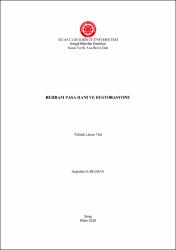| dc.contributor.advisor | Bilget Fataha, Ebru | |
| dc.contributor.author | Karaman, Buğrahan | |
| dc.date.accessioned | 2022-04-28T09:26:30Z | |
| dc.date.available | 2022-04-28T09:26:30Z | |
| dc.date.issued | 2019 | tr |
| dc.date.submitted | 2019-10-03 | |
| dc.identifier.other | xxvii, 305 | |
| dc.identifier.uri | https://hdl.handle.net/20.500.12418/12597 | |
| dc.description.abstract | İslamiyet sonrası Türk devletleri yerleşik hayatın gereklilikleri için, kendi
bünyesi ve coğrafyasında barındırdıkları insanların ihtiyaçları doğrultusunda imar
faaliyetlerinde bulunmuşlardır. Özellikle Osmanlı İmparatorluğu, kentlerindeki
dokuyu ticarethane ve konaklama imkanı sunan yapılarla desteklemişlerdir. Nitekim
devletin bu politikası halkına hizmet ederken, devletin varlığının güvencesi olan
ticareti de daha sağlam ayaklar üzerine dikme yoluna gitmiştir. Dış ticaret ağı, mal ve
malzeme tedariki, ticaret yollarının güvenliği ve elbette ki anıtsal ölçekli gerek
şehirler arası kervansaraylar ve şehir içi hanlarının yapılması ticari faaliyetleri bu
devir içinde hızlandıran neticelerdir.
Behram Paşa Hanı, Osmanlı Devleti’nin Sivas merkezinde yer alan 16. yüzyıl
şehir içi hanlarından biridir. Çalışmamızda Behram Paşa ve diğer şehir içi hanlarının,
kent dokusu ve ticari hayata ayrıca kente kattığı maddi ve kültürel getirilerden
bahsedilecektir. 2016 öncesinde atıl ve harabe vaziyette bulunan han daha sonra
restorasyon işlemleri ile tekrar eski sağlamlığına kavuşmuştur. | tr |
| dc.description.abstract | After the Islam, the Turkish states have engaged in the development activities
in line with the necessities of the settled life and in line with the needs of the people
they inhabit in its own structure and geography. In particular, the Ottoman Empire
supported the structure of the city with its buildings that provided accommodation
and accommodation. As a matter of fact, while this policy of the state served its
people, it started to trade trade, which is the assurance of the existence of the state,
on stronger feet. Foreign trade network, supply of goods and materials, security of
trade routes and, of course, the construction of inter-city caravanserais and urban
inns with monumental scale are the results that accelerate the business activities in
this period.
The Behram Pasha Inn is one of the 16th-century inner-city inns in the center
of the Ottoman Empire. In our study, the material and cultural benefits of Behram
Pasha and other inner city inns, including the urban texture and commercial life, will
be mentioned. The inn, which had been inactive and ruined before 2016, was
restored to its former glory with its restoration processes. | tr |
| dc.language.iso | tur | tr |
| dc.publisher | Sivas Cumhuriyet Üniversitesi-Sosyal Bilimler Enstitüsü | tr |
| dc.rights | info:eu-repo/semantics/openAccess | tr |
| dc.subject | Behram Paşa | tr |
| dc.subject | Türk | tr |
| dc.subject | Şehir-içi Hanı | tr |
| dc.subject | Osmanlı | tr |
| dc.subject | Ticaret | tr |
| dc.subject | Kültür | tr |
| dc.title | Behram Paşa Hanı Ve Restorasyonu | tr |
| dc.type | masterThesis | tr |
| dc.contributor.department | Sosyal Bilimler Enstitüsü | tr |
| dc.relation.publicationcategory | Tez | tr |















